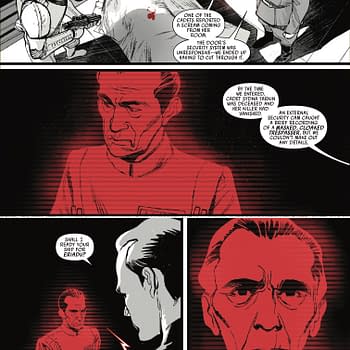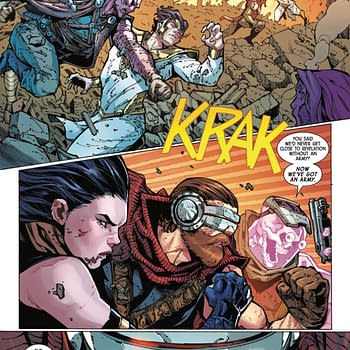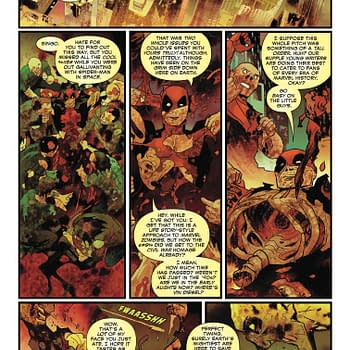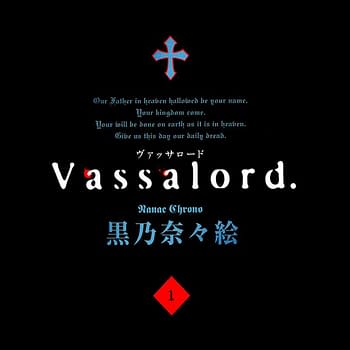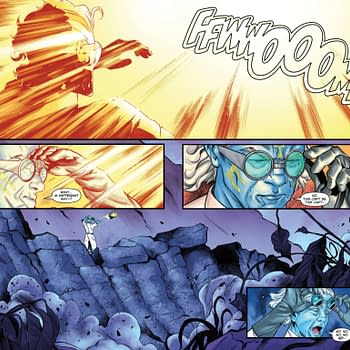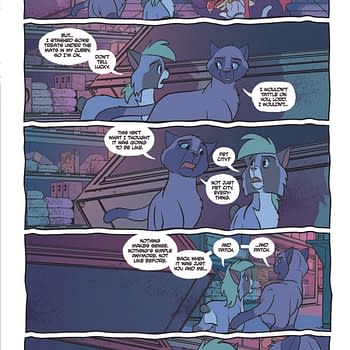Posted in: Comics | Tagged: Alan Moore, apps, Big Nemo, colleen doran, digital comics, electricomics, entertainment, jimmy's end, john reppion, leah moore, show pieces, the show
Alan Moore Gives Us A Tour Of 'Big Nemo' & The Digital World Of Electricomics

Their comics represent different avenues for the use of a toolkit that will be made accessible to comic creators for free as part of an open access system for the creation of digital comics, and through their functionality we can see quite a few alternatives available at the outset, including simple animation elements, the possibility of sound, using "tapping" to progress through the revelation of speech bubbles and panels, and even remarkable possibilities for "tipping" tablets backward and forward to guide storytelling and choosing the sequential relationships between panels. Electricomics is, as Alan Moore would agree, in its infancy, but it is an arrival that is worthy of note to the field of digital comics. It may well change the demographic of creators who feel comfortable using digital technology to create apps as well, since the architecture of the toolkit has been created with accessibility as a central concern.
Alan Moore joins us for the second part of his interview on Electricomics, in this segment focusing in on the tools that he and Colleen Doran used to create "Big Nemo" and why he feels that Electricomics blazes new trails in storytelling in visual media.

I was wondering if you could tell us about some of the tools you used to make this comic as far as you know.
Alan Moore: Well, the thing is, I was just trusting blindly in the tech people to be able to realize my fairly incoherent ideas. I suppose that one of the tools was the way that the panels actually appear. The order of the panels on the page, and things like that. And how a previous panel can disappear. How the balloons in a panel will appear in sequence with a "tap" and will fade out once read. And there were things like the way that characters move through either a series of stages or sometimes with a simple two-step animation. You can give, for example, in some of Winsor McCay's own arrangements, a static background that is getting bigger, and bigger, and bigger in each successive shot, while two characters in the foreground are "moving towards" it. They are staying the same size, but the background is getting bigger. We were doing that with the added element of a simple two-step animation where some of the figures are moving ever so slightly.
I believe that was in the fairground scene.
HMS: Yes, when they are entering the fairground, we see those features in "Big Nemo".
AM: Right. And when they are entering, there are people juggling colored balls, and there are people with one of those "test your strength" machines. With simple two-step movements just to liven things up. I think my comic was the only one where we were thinking of adding sound to it. We decided to do away with the idea of using actor's voices, and stick with balloons. Because that retains an important element of the comic book. I thought there was no reason why there couldn't be a certain amount of ambient sound if it could be synced up properly with the images. All of this was experimental. Most of these tools were purely for my comic, whereas the other comics use other things. Mainly because I was coming up with effects willy-nilly, without thinking of how much work people would have to do to realize them.
The result, though, is something that we're very proud of. We're very proud of what we've done on Electricomics. We think we've done something that is interesting and in some ways, delightful. But the actual toolkit was perhaps the biggest part of the project. This range of tools, by making them open source, enables the audience to actually get involved. If they are interested in programming, and a lot of young people are these days, they are being given their brushes and pens and pencils to get to work on digital comics of their own. I think that's probably the best way to actually push this medium forward, whatever medium it actually is. I'm not sure that it's comics. It's something that's emerged from comics, but I think that it might be something new, essentially. It's obviously got different laws than the laws of comics and different possibilities. Not better possibilities than the world of comics, just different ones.
And this is only a first stop. The whole thing is completely in its infancy. We just hope that we can actually get people to think about the storytelling values more than they are thinking about the whistles and bells. I don't think it's enough to simply adorn existing comic strips with the trimmings of this new medium. That was one thing that came up when I was doing my initial thought experiment on all of this. It struck me that actually, comics is probably the more sophisticated technology. Comics, consumed as a technology, is older, and has become much more sophisticated than digital comics, which are something new. I felt it would be a mistake to try to "enhance" things that the comics medium was probably doing perfectly well on its own.
AM: You don't want to to trick out a comic book page, like the work of McCay or the work of Will Eisner, or any of the great comic book geniuses. The way that they used the page, the technology of their thinking, and the application of their craft and technique, are already doing an immense amount of work, and are doing it elegantly. So, if this technology is going to genuinely add something to the experience of reading a comic, you have to think that through. You have to ask, "In what ways could this enhance a comic book?" Now, I don't think that I, probably, engaged with those possibilities quite as much as say, Pete [Hogan] or Leah [Moore] and John [Reppion]. Now, my comic could, with very few adjustments, be reproduced as a print comic. Which is good in some ways, but in others I regard that as a sign that I was being cautious. I wanted effects that I thought I knew would work.
Whereas with Pete's comic, where there are multiple ways of going through the story, or as, indeed, with "Sway", where you can navigate through the story in different ways—those were things I didn't engage with. However, as I've said, I was very pleased with how this first outing turned out.
And in any possible future outings, what I would want to do would be to continue the story, and frankly that is aided immensely by having the sublime Colleen Doran on the artwork. We had no idea who would be drawing this when I wrote the script. I think Jose Villarubia suggested her name, and I'd been a fan of her work since A Distant Soil. The job that she's done on "Big Nemo" is absolutely stunning. That rollercoaster, I believe that did almost drive her mad.

AM: Gorgeous, isn't it? She's exactly the right artist. So, I'm very pleased with how "Big Nemo" has turned out. Regarding the future, this strikes me as a very big world to play in, with lots of possibilities.
HMS: Do you mean the world of "Big Nemo" specifically, or the world of Electricomics?
AM: "Big Nemo" and this new medium, or whatever we should call it. This "new variant of comics" or this "new medium". The possibilities do seem vast. Daniel Merlin Goodbrey, at the very first Electricomics meeting, gave us a brief history of this form of comics, including some of the ways in which they'd been used and their experimental possibilities. Looking at "Big Nemo", I must say that I'd look forward to working with Colleen and trying some very different things too. We've got plans for the future of Electricomics. It's not going to be a "regular comic" as far as I know. When we've got enough new ideas and new material to add to the tool kit, then we'll do another issue, exploring things and expanding the toolkit, which will then be made open source. It's made more sense to us to give people the tools to actually make this stuff, and give them some sort of inspiration for the different ways they can explore this new medium.
HMS: Right, the comics released initially with the app are "examples" of possibilities for creators in how to use the tools.
AM: Yes, and of course, they'll be able to think of their own alternatives. When they actually see what these tools can do, they'll probably be using them in ways we've never dreamed of. When we've added to the toolkit, hopefully that'll only expand the possibilities for the readership creating their own comics. It just struck us as the properly democratic way to go.
The fact that it's all free.
HMS: Absolutely.
AM: As far as the future, we have some interesting ideas, but now may not be the time to talk about them yet. We want to carry this forward in as interesting a way as is possible. I think that we've made an interesting opening to what will hopefully prove to be a longer game.
HMS: Well, it's a tremendous thing just to see the launch, because I know how long the process has been. And I've talked to Leah and some of the other team members before about the steps along the way. She said something interesting to me once, that many of the people who created the comics which have released now with the app were purposefully people who are not necessarily tech savvy. So that it can show comics creators who may not have a background in technology that this is something that's not difficult to use and that they could potentially learn how easily.
AM: This is it, yes. Leah and John have got more technical savvy than probably anyone else on the project. I am probably the least technically aware of anybody. At least Garth Ennis handles e-mail and things like that. He's part of the modern day. Pete Hogan has e-mail, but he doesn't have a tablet. He probably views such things with superstitious revulsion in much the same way that I do…
HMS: [Laughter]
AM: But that is an important thing. There were some people on the net when this project was announced, I believe, saying things like, 'Alan Moore doesn't know anything about computers. How's he going to do something like this?' Which is rather missing the point. Lots of other people do know about computers. They will be helping me. The only important thing is if I have interesting ideas.
HMS: Right!
AM: And then we will see if those ideas can be implemented. You don't need to be au fait with technology or computers in general. Because if you've got somebody with an imagination, then art will be what it has always been, which is somebody with an imagination who is using certain tools to express that imagination. It's just that these tools are a bit more intangible and of a different order to the pens and brushes we've been using in the past. I suspect this will be less of a problem, in time. I believe that there are now children's computer games that actually teach them how to program and how to build their own games.
AM: So, I suspect this is not going to be an issue in 10 years, when a lot of this stuff will probably be as natural as breathing. And also a lot of the stuff we're bringing out right now with Electricomics will look Paleolithic. But such is the fate of any innovation. Especially in these rapidly moving times. I think, without having anything to base this on at all, that we have at least presented the digital comics field with some new ideas, hopefully in a new way. A different way of thinking about this exciting new medium.
HMS: Can I ask, when you imagined "Big Nemo" and the story of it, how does that experience compare with imagining The Show, or the way in which you imagined the comics scripts you're writing now, like Providence? Is there a different way of imagining for each of the three types of writing, or are they similar experiences for you?
AM: They are very different. Which is something that I've learned largely through doing the work on The Show. The thing is, with comics, even with complex comics like Providence, by the time that I have finished with my little rough notebook, making my scribbled drawings of my dialogue, I pretty much know what the finished comic will look like. I cannot imagine the glorious enhancement that Jacen Burrows will bring to it. I don't see it as beautifully as it will actually be realized, but structurally, I do see how it's all going to work, and how it's going to function. I can more or less see the finished product.
With films, that is completely different. With films, what I'd be doing in writing a screenplay is more or less providing a ground plan for a house, to use that analogy. So it's flat. If everybody follows my instructions in the plan, then it will be a functional structure, and hopefully an interesting one. But everyone who is working on it is an influence. Mitch [Jenkins'] directing will give a huge amount of the substance to the film. The performances from the actors will bring in a huge amount of the actual substance of the film. When Colin Goudie, our editor, is finished ingenious cutting it and pasting it together, that will be another part of the substance and the structure. So the finished edifice will be something that, no, I couldn't have imagined. I knew how the story was going to go, yes, and I'd got some idea of the visuals, but no, no real grasp at all of what the final experience would be like.
I'd say that Electricomics is somewhere almost exactly between those two points. As I said, I could imagine an ordinary comic strip presentation of "Big Nemo" with only a couple of changes. I could see that in my head in the same way that I would have been able to if it had been an ordinary comic. And I'd got a vague idea of what it might be like with the moving elements, and things like that. But the finished thing was a surprise. Not so much of a surprise as a film would have been because there are less people involved, and fewer processes. But there are still more people and more processes involved than in a regular comic book. It's that—the input of other people and other technologies that adds to the interesting uncertainty of how it's going to turn out.
HMS: [Laughter] That's a great phrase, "interesting uncertainty".
AM: Well, you know. A lot of art—if you're doing it right—it probably should be about interesting uncertainty. If you're absolutely certain how a thing is going to turn out, that's probably because either you or somebody else has done it before.
HMS: Ah! Good point.
AM: Really, the problem with art is finding new cliff edges to throw yourself over. Digital comics presents just such a cliff edge, and I think we've had a very soft and gentle landing from the sound of it.
A page from Sway, written by Leah Moore, John Reppion, and art by Nicola Scott, with colours by Jose Villarrubia and letters by Simon Bowland:



You can learn more about NESTA and the digital arts fund by following them on Twitter @nesta_uk or the hashtag #artsdigital
 You can learn more about Ocasta Studios through their website, and following them on Twitter @ocastastudios
You can learn more about Ocasta Studios through their website, and following them on Twitter @ocastastudios
Find the Electricomics app here. Find the Electricomics website here. Find the team on Twitter here.
Credits:
All photographs are copyright Mitch Jenkins/Orphans Of The Storm
Screengrabs are copyright Orphans Of The Storm
All art copyright Orphans Of The Storm
Big Nemo is written by Alan Moore with art by Colleen Doran, colours by Jose Villarrubia and letters by Erica Schultz
All animation and enhancement of the art in the app was done by Ocasta, namely Giulia Alfonsi, with assistance from Sean Gannon
Art prep and colour flatting is by Andy Bloor and Craig Scheuer
All Logo Designs are by Todd Klein














